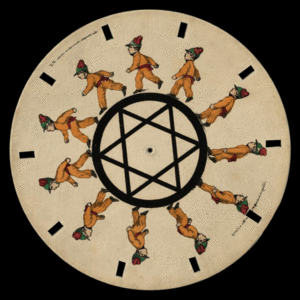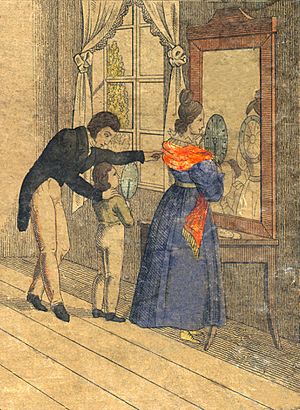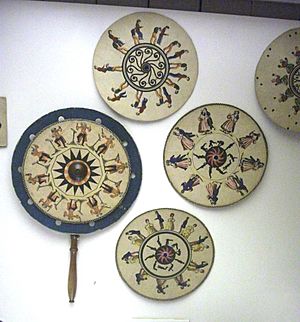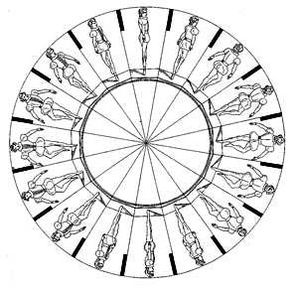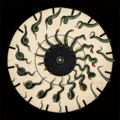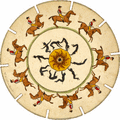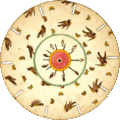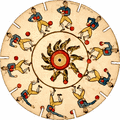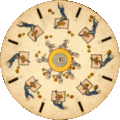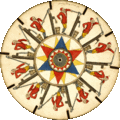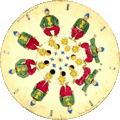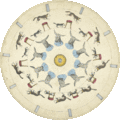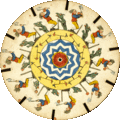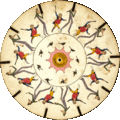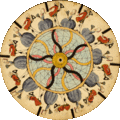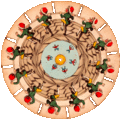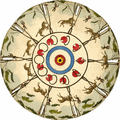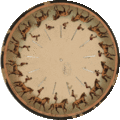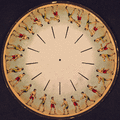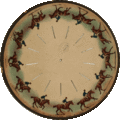Phenakistiscope facts for kids
The phenakistiscope was one of the very first devices that made pictures seem to move! It was a popular way to create short animations, like a very early GIF. People called it by many names, but "phenakistiscope" became the most common. This invention was a big step towards modern movies and animation. It could only show a short, repeating loop of movement.
Contents
What's in a Name?
When the phenakistiscope was first shown in a French newspaper in 1833, its name was explained. It came from two ancient Greek words: phenakizein, meaning "deceiving" or "cheating," and óps, meaning "eye" or "face." So, the name basically means "optical deception" or "eye trick."
The French company Alphonse Giroux et Compagnie first used the name "Phénakisticope" for their products. The inventor, Joseph Plateau, didn't name it at first. He later used "Phénakisticope" to talk about the versions others published. He also liked the name "Fantascope" for his own sets.
Another spelling, "phenakistiscope," might have come from a company called Forrester & Nichol. They called their sets "The Phenakistiscope, or, Magic Disc." The "scope" part of the name is common in devices that help you see things, like a telescope or microscope.
How It Works
A phenakistiscope usually looks like a spinning cardboard disc with a handle. Around the disc, there are many pictures that show different stages of an action, like a person dancing or an animal running. Small slits (narrow openings) are cut evenly around the edge of the disc.
To use it, you spin the disc and look through the moving slits at the pictures reflected in a mirror. The slits act like a shutter, letting you see each picture for a brief moment. This makes the images blend together in your mind, creating the illusion of smooth motion.
If the number of pictures matches the number of slits, the animation will seem to stay in one place. If there are fewer pictures than slits, the animation will appear to move backward. If there are more pictures than slits, it will seem to move forward.
Unlike later animation toys like the zoetrope, most phenakistiscopes could only be viewed by one person at a time. When the disc spun fast, the pictures would look a little stretched or curved. Sometimes, artists would draw the pictures slightly distorted in the opposite way to make them look normal when spinning.
Many phenakistiscope animations you see online today (like GIFs) are made with computer software. They don't show the slight distortions or flickering you would see with a real phenakistiscope.
Most of the discs sold were printed using a method called lithography and then colored by hand.
Who Invented It?
The phenakistiscope was invented almost at the same time by two different people in late 1832: Joseph Plateau, a physicist from Belgium, and Simon Stampfer, a geometry professor from Austria.
Plateau had been studying how our eyes see things. He noticed that if you looked at two spinning gears moving in opposite directions, they could appear to stand still. He also read about similar optical illusions. After many tries, he built a working model of his device in late 1832. He wrote about his invention in a scientific paper in January 1833.
Stampfer learned about similar optical tricks and was inspired to create his own device, which he called "stroboscope discs" or "optical magic discs." He thought about different ways to show the pictures, like on a disc or even a long strip of paper (which is similar to how film reels work). By February 1833, he had prepared several discs. He and his publisher received a patent for his discs in May 1833.
Both inventors created their versions around the same time, and they are both recognized for this important invention.
Becoming Popular
Stampfer's discs were first published in early 1833 and sold out very quickly! Later, an improved set of discs was released. Joseph Plateau also designed his own discs, which were published in London.
Soon, many other companies started making and selling phenakistiscopes. They often used similar designs, and it's likely that many companies copied each other's ideas without permission. Both Plateau and Stampfer were a bit unhappy that some of the discs being sold were not very well made.
Despite this, the phenakistiscope became very popular, and many different versions and names appeared on the market.
Different Kinds of Phenakistiscopes
There were many variations of the phenakistiscope:
- Some versions had a smaller picture disc that you placed on a larger slotted disc.
- Another common type had the picture disc on one end of a stick and the slotted disc on the other. This didn't need a mirror and was said to show clearer images.
- A company called Fores made an "Exhibitor" that had two slotted discs facing each other. This allowed two people to watch the animation at the same time without a mirror.
- A few discs had special shapes cut into their edges to make it look like the figures were crawling over the edge of the disc.
- Some phenakistiscopes came with a wooden stand and a hand-cranked mechanism to spin the disc.
- Later, starting in the 1850s, some phenakistiscopes were made with glass discs that could project the images onto a screen.
Joseph Plateau even combined his phenakistiscope with another invention called the Anorthoscope. This created a transparent disc with pictures that would animate when spun behind another black disc with slits. This allowed more than one person to see the animation at once.
Projecting Images
The idea of projecting phenakistiscope images came about in the 1840s. An Englishman named T.W. Naylor described a projector that would trace the pictures onto glass and project them.
Around 1851, an Austrian named Franz von Uchatius developed his own projector. His second model used a bright light to project the pictures one by one onto a screen. This machine was even used by a magician in his shows!
From the 1850s to the 1890s, a company in Paris sold different models of projection phenakistiscopes. These used large glass discs for the pictures.
Later, inventors like Thomas Ross and Henry Renno Heyl created their own projection systems. Heyl's "Phasmatrope" in 1870 could hold 16 photographic slides and project them one after another. He even had a voice actor behind the screen to make the show more lively!
Eadweard Muybridge created his famous Zoopraxiscope in 1879. This projector used glass discs with pictures based on his special "chronophotographic" photos, which captured movement in a series of still images.
Science and the Phenakistiscope
Even though the phenakistiscope became a popular toy, it was first invented through scientific research. Scientists continued to use it as a helpful tool to demonstrate ideas.
For example, a Czech scientist named Jan Purkyně used his version, called the Phorolyt, in his lectures starting in 1837. He even used it to show how a heart beats!
A German physicist named Johann Heinrich Jakob Müller published a set of discs in 1846 that showed different types of waves, like sound waves or water waves.
Eadweard Muybridge, who was famous for his studies of movement using photography, built a phenakistiscope projector. He would trace his photographs onto glass discs to show how animals and people moved. He sometimes even changed the pictures to make them look better for the animation. One disc showed a running horse skeleton, which was probably the first time a stop motion technique was used successfully! Muybridge used his projector in many lectures about how humans and animals move.
Today's Legacy
The Joseph Plateau Award, a Belgian movie award given from 1985 to 2006, had a trophy that looked like a phenakistiscope.
Today, you can even find music records that have phenakistiscope-like animations on them! When these special records spin and are viewed under a certain light, they create cool moving images.
Gallery
See also
 In Spanish: Fenaquistoscopio para niños
In Spanish: Fenaquistoscopio para niños


